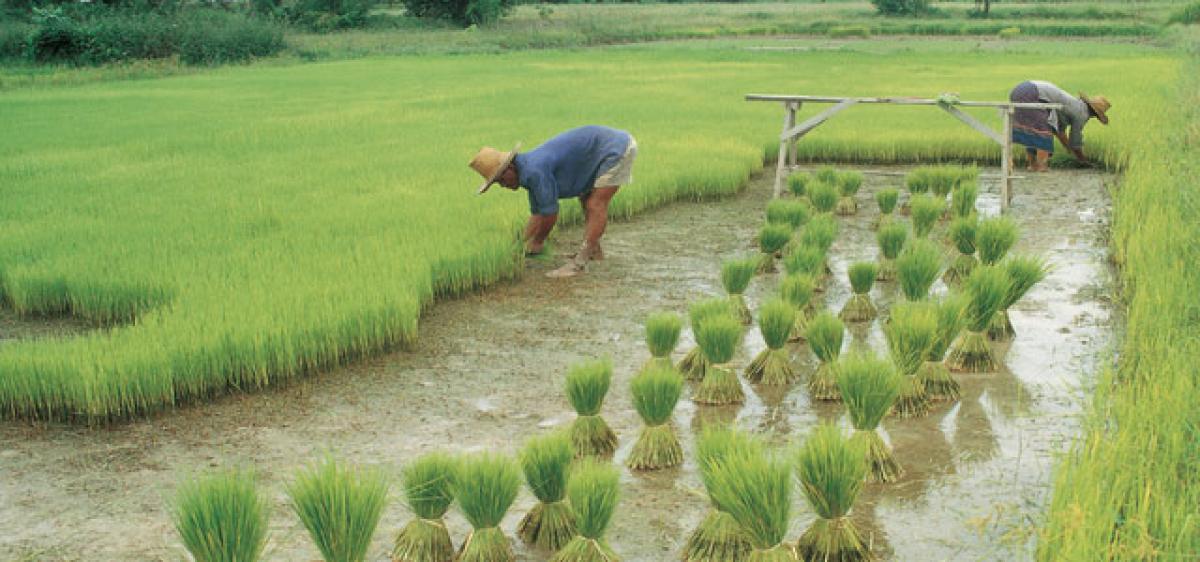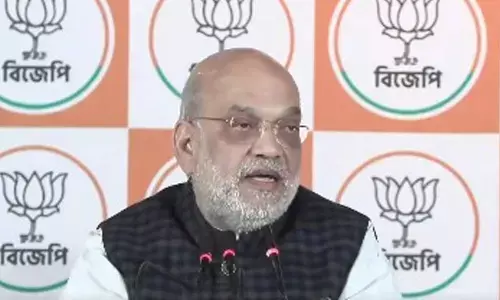Agricultural Produce Marketing Act and related issues

Marketing and trade activity comes as a part of the value chain for any commodity and yet it is the most important determinant for all other activities.
Marketing and trade activity comes as a part of the value chain for any commodity and yet it is the most important determinant for all other activities.
All the input expenses for labor, materials and capital are rewarded at this stage, which shall include some incentive over and above inputs.
Agricultural products, in a developing country remain in uniform demand throughout year, while production of most of them is concentrated in some part of the year.
This results in fluctuation in prices which can change equations of profit for the farmer. Apart from this, in a federal and diverse country, every state or region has diverse resources, consumption patterns and rules regarding taxation, levies, sale etc., which makes numerous hurdles in interstate trade.
Integration of all the regional markets into national market is desirable in interest of both farmers and consumers. Farmers will get rewarding prices even if demand is not there in their region, on other hand if there is less production in a state, consumer will still be able to get products at reasonable prices.
Same is true for international markets that have been seen few years back when prices of sugar were up swinging, and then sugar imported from Brazil came to rescue Indian consumers.
However, integration of national and international markets, at times can make domestic and regional farmer vulnerable because of external forces. For these reasonable regulation is imperative.
Generally, the procurement and disbursal by government involves about 33% of total production of food grains.Another, 33% is captive consumed by farmers and residue is left for open markets. Trade of this quantity is also heavily regulated by the government through Agricultural Produce Market Committee (APMC) act and various taxes and levies.
So, less quantity left in market is in itself a strong reason for price rise, which is further supplemented by monopoly of government in open market. Further, under current system there are number of intermediaries who add little value to the product, but increase price dramatically by commissions or trading margins. This all coupled with lack of integration of market leaves farmers and consumer vulnerable alike.
Agricultural Produce Market Committee (APMC) Act
- Agriculture is a state subject and almost all state governments enacted APMC act in 1950’s or so, to bring transparency and end discretion of traders.
- This is extension of overall government policy which is directed toward food security, remunerative prices to farmers and fair prices to consumers.
- However, widespread perception for this act is that it has worked contrary to almost every stated objective, at least in recent past.
- It should be noted that though current system controlled by APMC is quite inefficient, yet it is far improvement from pre-APMC/50’s era.
- At that time there was no control at all. Money lender, traders, bankers etc. were often one person. This all in one role of middleman resulted in perpetual indebtedness of farmer.
- Under the APMC acts, States are geographically divided into markets which are headed by market committees and any production in that area shall be brought to a market committee for sale.
- This is applicable to ‘notified agricultural products’ which differs from state to state and generally includes most of the important cereals, vegetables and other horticulture products.
- Notified products are meant to be brought to the market committee and auctioned in presence of the farmer.
- In this Market committee (popularly called Mandi) there are commissions agents (called arhatiyas) who hold license and are allotted a shop in the market.
- Farmer and buyer have discretion to go to any agent in this market, based on personal relations.
- Normally farmers chose agents from their own village and are influenced by age old relations of money lending.
- There are huge numbers of commission agents in a particular APMC dealing in same crop, which results in constant price discovery and adjustments for that particular crop.
- At same time buyers, which may be rice mill, flour mills, cotton ginning mill owners, come to procure these products.
- They make their bids and if these bids are fair, will give best return to farmers. But unfortunately this is not so.
- Shortcomings in Current APMC system
- Monopoly of APMC – Monopoly of any trade (barring few exceptions) is bad, whether it is by some MNC corporation by government or by any APMC. It deprives farmers from better customers, and consumers from original suppliers.
- Cartelization – It is quite often seen that agents in an APMC get together to form a cartel and deliberately restraint from higher bidding. Produce is procured at manipulatively discovered price and sold at higher price. Spoils are then shared by participants, leaving farmers in lurch.
- Entry Barriers – License fee in these markets are highly prohibitive. In many markets farmers were not allowed to operate. Further, over and above license fee, rent/value for shops is quite high which keeps away competition. At most places only a group of village/urban elite operates in APMC.
- Conflict of Interest – APMC play dual role of regulator and Market. Consequently its role as regulator is undermined by vested interest in lucrative trade. They despite of inefficiency won’t let go any control. Generally, member and chairman are nominated /elected out of the agents operating in that market.
- High commission, taxes and levies: Farmers have to pay commission, marketing fee, APMC cess which pushes up costs. Apart from this many states impose Value Added Tax.
- Other Manipulations – Agents have tendency to block a part of payment for unexplained or fictitious reasons. Farmer is sometimes refused payment slip (which acknowledges sale and payment) which is essential for him to get loan.
APMC Model Act
Taking these concerns into cognizance, Central Government appointed a working group which recommended a Model APMC act.
Salient features are –
- Farmer doesn’t need to bring his produce to APMC Mandi. He can directly sell it to whomever he wants. But, if he doesn’t bring his produce to Mandi, then he can’t stand for election in that APMC marketing committee.
- It allows alternate markets such as direct purchase centers, private market yards/mandis.
- It increased responsibility of APMCs on following lines –
- Full payment should be made on day of sale itself.
- Quantity brought and prices should be displayed near arrival gate. Its being done electronically in many APMCs
- Promote private partnership in management of APMCs
- It shall make efforts to build facilities for Processing and other value additions
- Ensuring transparency in Pricing and Transactions in the market
- It allows Public Private Partnership in the ‘management and development’ of agricultural markets in the country for post-harvest handling, cold storage, pre-cooling facilities, pack houses etc.
- It not only allows, but strongly advocates for contract farming. It also provides for dispute resolution mechanism.
- It mandates establish ‘State Agricultural Produce Marketing Standards Bureau’ for Grading, Standardization and Quality Certification.
- It provides for abolishment of commission agent system. Payments will be made for facilities such as grading, sorting, and processing.
APMC as Road Map
- APMC model act is a sort of roadmap for states for their respective APMC acts which shall be amended.
- States has adopted Model APMC in piecemeal manner as per vested interests of various pressure groups.
- Most of states haven’t abolished system of commission agents as they constitute influential people.
- Bihar repealed APMC act in 2006, while Kerala never had any APMC act, but situation is no better there as thrust on development alternate markets is lacking.
- Demand is just to dismantle monopoly of state regulated APMCs and increase competition.
- APMC can continue and with competition they can get efficient overtime.
Why model APMC Act is also considered inappropriate?
- The model legislation has actually given rise to a conflict of interest, as the APMC, which is a major player, is also the regulator/registering authority.
- There is reluctance on part of state governments to reform the APMC legislation, as it generates huge revenues.
- Some states have created entry barriers by prescribing either prohibitive license fees for setting up such markets, or the minimum distance between private markets and APMC markets.
Economic Survey on APMC Act
- The provisions of the State Agricultural Produce Marketing Committee (APMC) Acts have prevented creation of competitive conditions in the distribution of commodities and creation of a national market for agricultural commodities.
- Taking a cue from the success of direct marketing efforts of states, the APMC/other market infrastructure may be used to organize farmers markets. FPOs/self-help groups (SHGs) can be encouraged to organize farmers markets near urban centers, malls, etc. that have large open spaces. These could be organized every day or on weekends, depending on the concentration of footfalls.
- Include ‘facilitating organization of farmers markets’ under the permitted list of corporate social responsibility (CSR) activities under Companies Act 2013, to encourage companies engaged in agri-allied activities, food processing etc. to take up this activity under CSR and also help in setting up supply chain infrastructure. This would be similar to the e-Choupal initiative of ITC Ltd., but under CSR.
- All the above facilitators can also tie-up a link to the commodity exchanges’ platform to disseminate spot and futures prices of agricultural commodities
Some measures that would facilitate the creation of a barrier-free national market are:
Alternate Marketing ChannelsDirect Marketing
- APMC model act promotes direct marketing. As farmer is allowed to sell his goods outside APMC, he can now under APMC model act, directly sell to consumer.
- This completely eliminates middleman and narrows gap between farmer’s sale price and price paid by consumer.
- There are numerous successful examples all over India such as Apni Mandi in Punjab, Rythu Bazar in Andhra Pradesh, Uzhavar Sandhai in TN, Shetkari Bazaar in Maharashtra, Hadaspur Vegetable Market in Pune, Krushak Bazaar in Odisha and Kisan Mandi in Rajasthan.
- Central government sponsors ‘Agricultural marketing Infrastructure, Grading & standardization Scheme’ for development of infrastructure for direct marketing in which capital subsidy of 25% is available (33.33% in NE states).
Contract Farming
- Under contract farming inputs material may be provided by purchasing party for a particular crop and there is a crop buyback agreement in advance Quality is specified in advance.
- This is mainly entered into by big corporate who are in business of food processing. So far there has been mixed results.
- It removes uncertainty of Income for the farmer and he can fetch good prices.
- But this all depends upon ready availability of genuine information about the market trends.
- It is seen that there is stark information asymmetry between corporate and farmers.
- This open up avenues for exploitation of farmers as these are long term contracts, once agreed by farmer at lower price, market price doesn’t matter for contract period.
Future contracts and negotiable warehouse receipts in agriculture
- A futures contract is a contract between two parties where both parties agree to buy and sell a particular asset of specific quantity and at a predetermined price, at a specified date in future.
- For example of an Exporter – Exporter sells goods to USA at 3 month credit at $ 1 lakh. At this time exchange rate of 1$ is Rs 60. So he expects to receive Rs 60 lakh After 3 months. But in 3 months exchange rate can go down to Rs 57. This will cause him loss of Rs 3 lakhs.
- So, at time of sale, exporter can enter into ‘currency futures’ sale contract. He will enter into contract with banker under which banker promises to
1.Buy dollars after 3 months,
2.Fixed quantity i.e. $ 1 lakh,
3.At predetermined rate – whatever rate is going in market for ‘3 months currency futures’
- At end date, contract may be either settled by delivery of dollars by exporter to bank (at predetermined price/contract price) or by settling price difference market and contract price in cash.
- These contracts between two parties are tradable like commodities on various exchanges. Note that, whenever exchange rate of a $ will vary, (below or beyond Rs 60) it will influence value of the contract itself.
- Hence, these contracts are instruments for Risk management, price discovery and trading.
- This trading attracts intense scrutiny of market analysts for prediction of future trends of demand and supply, which in turn yield much useful data for manufacturers and producers.
- This has much utility for the farmers as they can decode future trends and plan their production accordingly.
- Farmer can similarly sell his production in advance in futures market and buyers can buy in futures market.
- In 2003 futures trading in all agricultural commodities was allowed and in 2007 The Warehousing (development and Regulation) Act, 2007 was passed. This created ‘Warehousing Development and Regulating Authority’ (WDRA).
- WDRA introduced a concept of ‘Negotiable Warehouse Receipt’. There are WDRA certified warehouses all over India, in which farmers can deposit there produce and they will get a receipt (Negotiable Warehouse Receipt) acknowledging quantity, type, category etc. of crop.
- This receipt can be used by farmers to get loans, to make payments or to settle any other type of claim. This receipt will be accepted by any ‘certified warehouse’ in India and possessor of this receipt can get quantity mentioned in it.
- The Negotiable Warehouse Receipts (NWR) system aimed at not only helping the farmers to avail better credit facilities and avoid distress sale but will also to safeguard financial institutions by mitigating risks inherent in credit extension to farmers.
- However, this to work effectively need a market based economy and free determination of prices. Various commodities are time and again banned for futures trading which keeps farmers and investors away.
- Further, there was scam in commodity exchange NSEL; it was found that stock of underlying assets, on basis of which contracts were entered, didn’t existed. Consequently, NSEL failed to settle its contracts.
International Trade
- India is among largest producers for products like wheat, rice, milk, pulses etc., but its share in agro global trade is much lower.
- This is partially due to heavy domestic consumption and rest due to non-coherent and unpredictable policies.
- There are quantitative restrictions which differ from crop to crop and time to time.
- Few years back cotton exports were suddenly banned after domestic prices rise and soon ban was lifted. There are export quotas, beyond which export is not allowed.
- Trade of basmati rice was liberalized in 1990’s and since then its prices are almost integrated to international prices which are more remunerative to farmers.
- Exports of agro product were valued at USD 32.3 billion in 2013-14, a jump of 122 per cent from 2008-09. But big part of this was offloading of surplus stocks by FCI in foreign markets.
- Import of one lakh tons of rice was undertaken over a five month period from Myanmar for augmenting the TPDS supplies in the north-eastern states.
- Such avenues need to be explored especially as they could be more economical than transporting rice from surplus states like Punjab or AP, and would limit FCI’s Procurement, and consequently, distortion, in the domestic market.
Essential Commodities Act
- The EC Act, 1955 provides for the ‘regulation and control’ of production, distribution and pricing of commodities which are declared as essential for
- maintaining or increasing supplies or
- for securing their equitable distribution and
- Availability at fair prices
Major commodities are covered under the act. Some of them are:
- Petroleum and its products, including petrol, diesel, kerosene, Naphtha, solvents etc
- Foodstuff, including edible oil and seeds, vanaspati, pulses, sugarcane and its products like, khandsari and sugar, rice paddy
- Jute and textiles
- Drugs- prices of essential drugs are still controlled by the DPCO
- Fertilizers- the Fertilizer Control Order prescribes restrictions on transfer and stock of fertilizers apart from prices.
- The Drug Price Control Order (DPCO) or Fertilizer Control Order and such other orders have also been issued under the powers of the ECA.
- The Act is thus pro-consumer and impacts at the level of the wholesaler and retailer.
- The Act empowers the Centre to order states to impose stock limits and bring hoarders to task, in order to increase supplies and cool prices. Generally the Centre specifies upper limits in the case of stock holding and states prescribe specific limits.
- However in case there is a difference between states and the Centre, the act specifies that the latter will prevail.
- In 2002 and 2003 an order was passed removing the licensing requirements, stock limits and movement restrictions on all specified foodstuffs.
- These orders allowed dealers to freely buy, stock, sell, transport, distribute, dispose, acquire, use or consume any quantity in respect of rice/paddy, wheat, coarse grains, sugar, edible oils and oilseeds, pulses, jagery, Wheat products etc.
- However, later in 2006 due to price rise in agro products, state governments requested for restoration of powers under EC act and it was done by central government. Since then there have been regular on and off policy.
- Different states put different limits on stock. As of now only sugar and wheat stands denotified by central government. Recently potato and onions were added to the list as inflation control measure.
- While it is true that at times hoarding of commodities can cause shortage in market, yet ban on stocking runs contradictory to government policy directed toward food processing and cold storage.
- If an entrepreneur invests in cold storage facility, he is supposed to stock something to utilize storage space and for profit. Ban on storage can demotivate investment storage capacities.
- Further, thrust should be on dismantling incentives to stock products for long period. From long experience it has been seen that government has limited capacity to restrict illegal stocking.
- In this scenario inter-regional and inter-temporal variation in prices of crops should be brought down.
- As already said, most crops are produced seasonally, but are consumed throughout the year.
- Uniform supplies of these crops throughout year can be insured by increasing competition at middle of supply chain i.e. between wholesalers/retailers.
- This shall be supplemented by adequate investment in supply chain infrastructure.
- Seen most of these institutions were designed in 1950’s and 60’s in response to formidable challenges of food security and farmer protection. This was followed by green revolution, then by liberalization of economy. This gave India abundance of grains and new trading mechanism like futures, NWR came to fore.
- In all these changes, reformation and redefinition of role of these institutions was overlooked.
- Consequently, they gradually moved in opposite directions. To hold them together, government needs to make a coherent policy to redefine role of these institution and underlying mechanisms.
- Recognizing that a competitive market, besides adding to the welfare of the producers and consumers also plays a contributory role in poverty alleviation, the recent Budget also highlighted that farmers and consumers’ interest will be further served by increasing competition and integrating markets across the country.
- While these are discrete measures, a holistic policy with across-the-board reforms would enable the Indian agricultural market to cross the Rubicon and progress towards Achieving Pareto efficiency.
Syllabus and Expected questions
1.‘By and large, the APMCs have emerged as some sort of government-sponsored monopolies in supply of marketing services/ facilities, with all drawbacks and inefficiency associated with a monopoly’ ; Explain and suggest alternatives?
2.What are ‘Negotiable Warehouse Receipts’? What are its benefits? Explain.
3.Why it is important to integrate national and international agricultural markets? Examine.
GS paper-II
- Government policies and interventions for development in various sectors and issues arising out of their design and implementation.
- Welfare schemes for vulnerable sections of the population by the Centre and States and the performance of these schemes; mechanisms, laws, institutions and Bodies constituted for the protection and betterment of these vulnerable sections
- Issues relating to poverty and hunger.
GS paper-III
- Issues related to direct and indirect farm subsidies and minimum support prices; Public Distribution System- objectives, functioning, limitations, revamping; issues of buffer stocks and food security; Technology missions; economics of animal-rearing.














